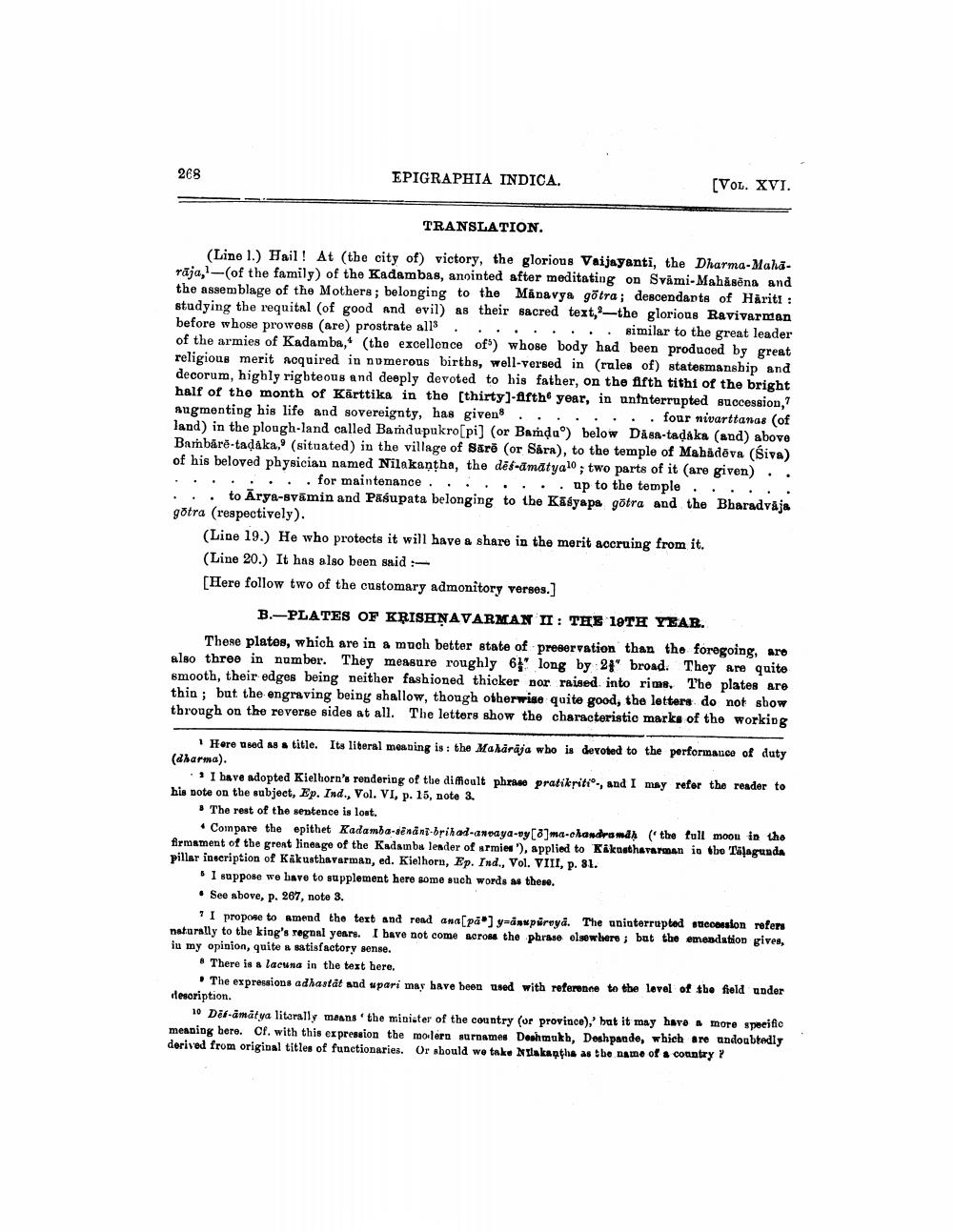________________
268
EPIGRAPHIA INDICA.
(VOL. XVI.
TRANSLATION.
(Line 1.) Hail! At (the city of) victory, the glorious Vaijayanti, the Dharma-Maharaja-(of the family of the Kadambas, anointed after meditating on Svami-Mahäsēna and the assemblage of the Mothers; belonging to the Mänavya gotra; descendants of Hariti : studying the requital (of good and evil) as their sacred text, the glorious Ravivarnan before whose prowo88 (are) prostrate alls. ...... similar to the great leader of the armies of Kadamba, (the excellence of) whose body had been produced by great religious merit acquired in numerous births, well-versed in (rales of) statesmanship and decorum, highly righteous and deeply devoted to his father, on the Afth tithi of the bright half of the month of Kārttika in the [thirty)-fifth year, in untnterrupted succession, augmenting his life and sovereignty, has given ........ four nivarttanas (of land) in the plough-land called Bandupukro[pi] (or Banda) below Dåsa-tadaka (and) above Barbārē-tadáka,' (situated in the village of Sārē (or Sára), to the temple of Mahadēva (Siva) of his beloved physician named Nilakantha, the def-āmatyalo; two parts of it (are given).. . . .. . for maintenance . . . . . . . . up to the temple. . . . . . ... to Arya-svāmin and Pasupata belonging to the Kikyapa götra and the Bharadvaja götra (respectively).
(Line 19.) He who protects it will have a share in the merit accruing from it. (Line 20.) It has also been said: [Here follow two of the customary admonitory verses.]
B.-PLATES OF KRISHNAVARMAN II: THE 19TH YEAR. These plates, which are in a much better state of preservation than the foregoing, are also three in number. They measure roughly 61 long by 24" broad. They are quite smooth, their edges being neither fashioned thicker nor raised into rims. The plates are thin; but the engraving being shallow, though otherwise quite good, the letters do not show through on the reverse sides at all. The letters show the characteristic marks of the working
Here used as a title. Its literal meaning is: the Maharaja who is devoted to the performance of duty (dharma).
I have adopted Kielhorn's rendering of the difficult phrase pratikriti®and I may refer the reader to his bote on the subject, Ep. Ind., Vol. VI, p. 15, note 3
The rest of the sentence is lost.
• Compare the epithet Kadamba-sinani-brihad-anvaya-oy[8]ma-chandrand (the full moon in the firmament of the great lineage of the Kadamba leader of armies'), applied to Kikasthavarman in the Talagunda pillar inscription of Kikusthavarman, ed. Kielhorn, Ep. Ind., Vol. VIII, p. 81.
" I suppose we have to supplement here some such words as these. • See above, p. 287, note 3.
1 I propose to amend the text and read ana(pa) yannpüreya. The uninterrupted sticcession refers naturally to the king's regual years. I have not come across the phrase elsewhere, but the emendation gives, in my opinion, quite a satisfactory sense.
* There is a lacuna in the text here.
The expressions adhaståt and spari mar have been used with referenne to the lovel of the field under description.
10 Dél-amatya literally means the minister of the country (or province),'hat it may have a more specific meaning bere. Cf. with this expression the molern surnames Deshmukh, Deshpande, which are undoubtedly derived from original titles of functionaries. Or should we take a tlakaaths as the name of a country?




